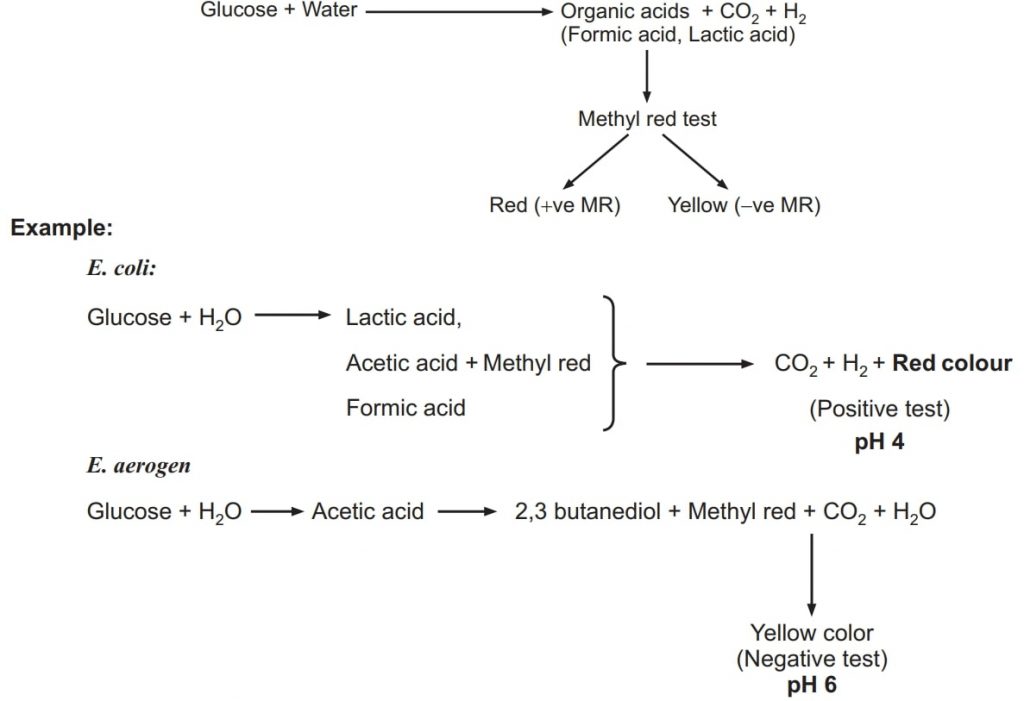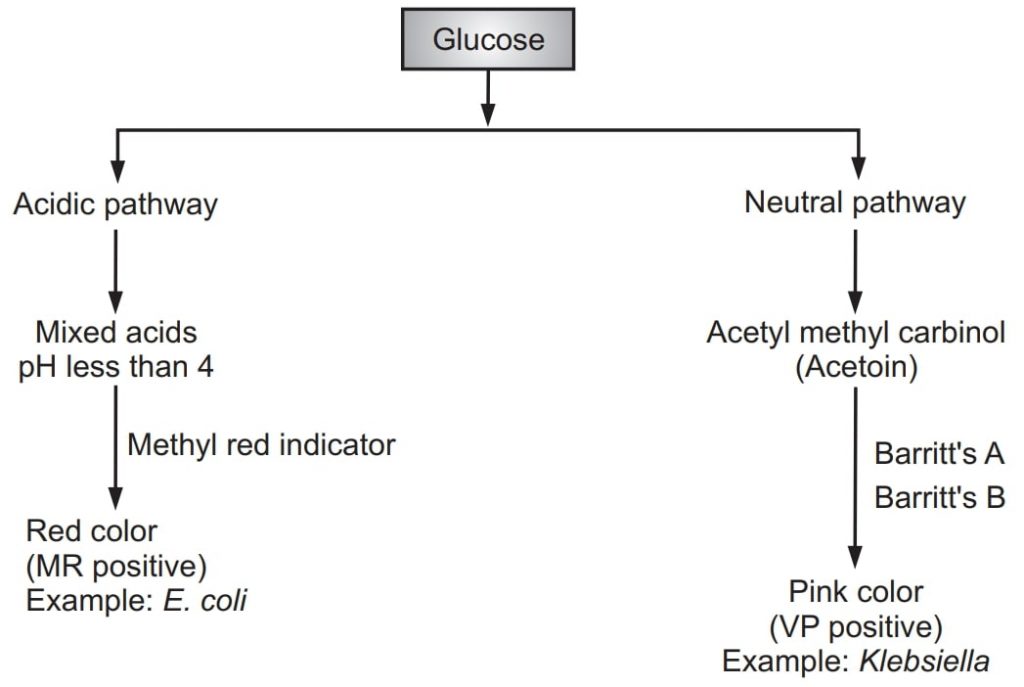Biochemical Test (IMViC) : It is a biochemical series of tests including the following tests: Indole, Methyl Red (MR), Voges-Proskauer (VP), and Citrate. All of the series was designed to differentiate among the Enterics (family Enterobacteriaceae).
I = Test for production of indole from tryptophan.
M = Methyl red test for acid production from glucose.
Vi = Voges-Proskauer test for production of acetoin from glucose.
C = Test for the usage of citrate as a carbon source.

Significance of Biochemical Test (IMViC) :
- This test is useful for differentiating the Enterobacteriaceae, especially when used alongside the urease test.
- Particularly it is used to differentiate E. coli, Enterobacter aerogens, Enterobacter cloacae and Klebsiella pneumonia.
- Four different tests are used viz. indole test, methyl red test, Voges Proskauer test, and citrate test.
- These four tests are combined with those carbohydrate tests to identify unknown bacterial species.
- This test detects the motility of bacteria and disulphane (H2S2) production.
Indole test:
Table of Contents
Some microorganisms can metabolize tryptophan by the tryptophanase. It is based on the principle of the formation of a hydrolytic product from an amino acid tryptophan.
Media: Sulfide Indole Motility (SIM); Tryptophan is used as substrate.
Reagent: Kovac’s reagent (Consist of isoamyl alcohol, para-dimethyl amino benzaldehyde, and concentrated hydrochloric acid). It is used to determine the ability of the organism to split indole from the amino acid tryptophan.
Colour: Pink or red indicates a positive test.
Tryptophan → Tryptophanaseindole + Acid pyruvate + NH3 → Kovac’s Reagent
The upper organic layer forms red colour (positive for indole); black (production of H2S2) and motility (turbidity forms) of bacteria.
Example: Proteus mirabilis can differentiate from Proteus Vulgaris by this test. P. Vulgaris shows a positive test (red or pink).
Methyl Red Test:
This test is a qualitative test for acid production. The bacteria are grown in MR-VP broth. It requires positive organisms to produce strong acids likely lactic acid, acetic acid, formic acid from glucose via the mixed acid fermentation pathway. Only those organisms that are maintained low pH (4-5), give a positive test for methyl red indicates mixed acid fermentation. In alkaline medium, it gives yellow colour (Negative test) indicating negative test for fermentation.
Significance:
- It is used to identify bacteria to produce pyruvic acid from glucose metabolism.
- This test is used to differentiate E. coli and E. aerogens.
Medium: MR-VP medium. It contains glucose, peptone and buffer (buffer will neutralize weak acids so that only strong stable acids will be detected by methyl red).

Voges-Proskauer Test:
The test is mainly based on the principle of conversion of glucose to acetyl methyl carbinol. After the breakdown of glucose, it reacts with alpha naphthol and potassium hydroxide to form a red colour solution, known as acetoin.
Reagents used: Barritt’s A and Barritt’s B which are mainly alpha naphthol and potassium hydroxide respectively. When these reagents are added to the broth containing acetyl methyl carbinol, it changes to pink colour after 20-30 minutes. This indicates the reaction is positive.
Procedure:
- Pipette out 1.0 ml of MRVP broth into an empty sterile tube.
- Add 0.6 ml of alpha naphthol and 0.2 ml of potassium hydroxide respectively.
- Shake the tube well and stand for 20-30 minutes.
- Observe and record the colour.
Example: E. coli does not produce red colour (Negative test) whereas Enterobacter and Klebsiella give a positive test.
Principle of MR-VP Test:

Citrate Test:
Objective:
- This test is used to determine the ability of an organism, using the enzyme citrate, to use citrate as its sole carbon source.
- Used occasionally to assist in the identification of enterobacteria.
- Inorganic ammonium salt is used as the sole nitrogen source.
- It utilizes Simmon’s citrate media to determine the growth of bacteria.
Principle: Breakdown of ammonium salt gives ammonia and hydroxides. These hydroxyl ions raise the pH and that changes the colour of the bromophenol blue indicator from green to royal blue.
When the bacteria metabolize citrate, the ammonium salts are broken down to ammonia, which increases alkalinity. The shift in pH turns the bromothymol blue indicator in the medium from green to blue above pH 7.6.
Reagent: Bromothymol blue indicator.
Procedure: Inoculate the slant of Simmons citrate agar media (pH 6.9) with the bacterial
culture by streaking the surface of the media. Then incubate at 37°C for 1-2 days. Observe and record the colour changes.
Observation: If the organism did not grow, the slant remains green. This indicates the test is negative. Example: E. coli.
If the organism grows, the slant became partially or completely Prussian blue.
Example: Klebsiella pneumonia.
Positive Reaction: Growth with colour change from green to intense blue along the slant.
Examples: Salmonella, Edwardsiella, Citrobacter, Klebsiella, Enterobacter, Serratia, Providencia, etc.
Negative Reaction: No growth and no colour change; Slant remains green.
Examples: Escherichia, Shigella, Morganella, Yersinia etc.
Limitations:
1. Some organisms are capable of growth on citrate and do not produce a colour change. Growth is considered a positive citrate utilization test, even in the absence of a colour change.
2. Tests with equivocal results should be repeated.
3. The reactions of this medium alone are not sufficient for the identification of the species level.
Make sure you also check our other amazing Article on : Identification of Bacteria